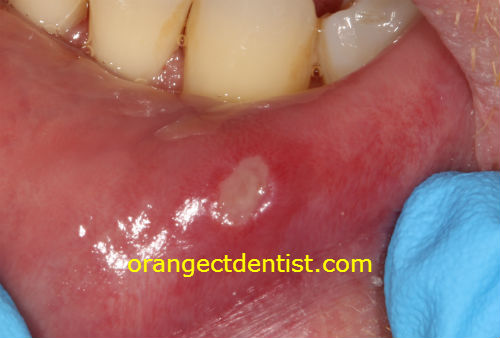Aphthous ulcers, known also as canker sores or aphthous stomatitis, are small painful ulcers inside the oral cavity. They can appear on the tongue, the lips, the inside tissue of the cheeks, and the throat. Many patients will refer to them as “cold sores.”
Photo of an Aphthous Ulcer

Aphthous ulcer on the lower lip of a patient. Photo by Dr. Nicholas Calcaterra
As seen on the photograph to the left, this aphthous ulcer is on the lower lip. It has a reddish halo surrounding the whiter ulcerated tissue. It was painful to the touch and we had to be extra gentle during the dental cleaning.
At the point when this photograph as taken, the canker sore had been present for nearly 3 days. When we followed up with the patient nearly one week later, she said the ulcer was present for approximately three more days after her cleaning appointment.
Aphthous ulcers can be so painful that it can cause patients to postpone their dental appointments. On many occasions we’ve had to reschedule patients because they did not want to receive dental care while they had an active canker sore.
Why Aphthous Ulcers Occur
In the abscence of certain systemic conditions, there is no universally accepted mechanism for why they occur. Theories include:
- Certain vitamin deficiencies (usually Vitamin B12 and/or folate)
- Stress
- Localized trauma to the area
- Hormonal changes
- Using a toothpaste with Sodium Lauryl Sulfate (note that the research on this is still preliminary; it is summarized here)
Aphthous-like ulcers are found in certain systemic conditions. These include Beçhet’s Disease, Reiter’s Syndrome, cyclic neutropenia, celiac disease, and others.
Note that aphthous ulcers are NOT associated with cold sores or herpes labialis.
Treatment of Canker Sores

Canker sore on the inside of the lower lip.
There is no treatment to prevent canker sores (other than attempting to correct the causes listed above). Treatment is primarily palliative in order to relieve the discomfort.
In our office, should a patient request a solution, we will either:
- Prescribe an ointment – usually Kenalog in Orabase – which is a combination of a topical anesthetic or steroid. This acts to provide pain relief and to minimize the localized swelling and inflammation.
- Use of a localized curettage agent to remove the affected tissue and rapidly replace it with healthy tissue. The agent we use is DEBACTEROL and it has a long track record of successful application for these types of cold sores.
